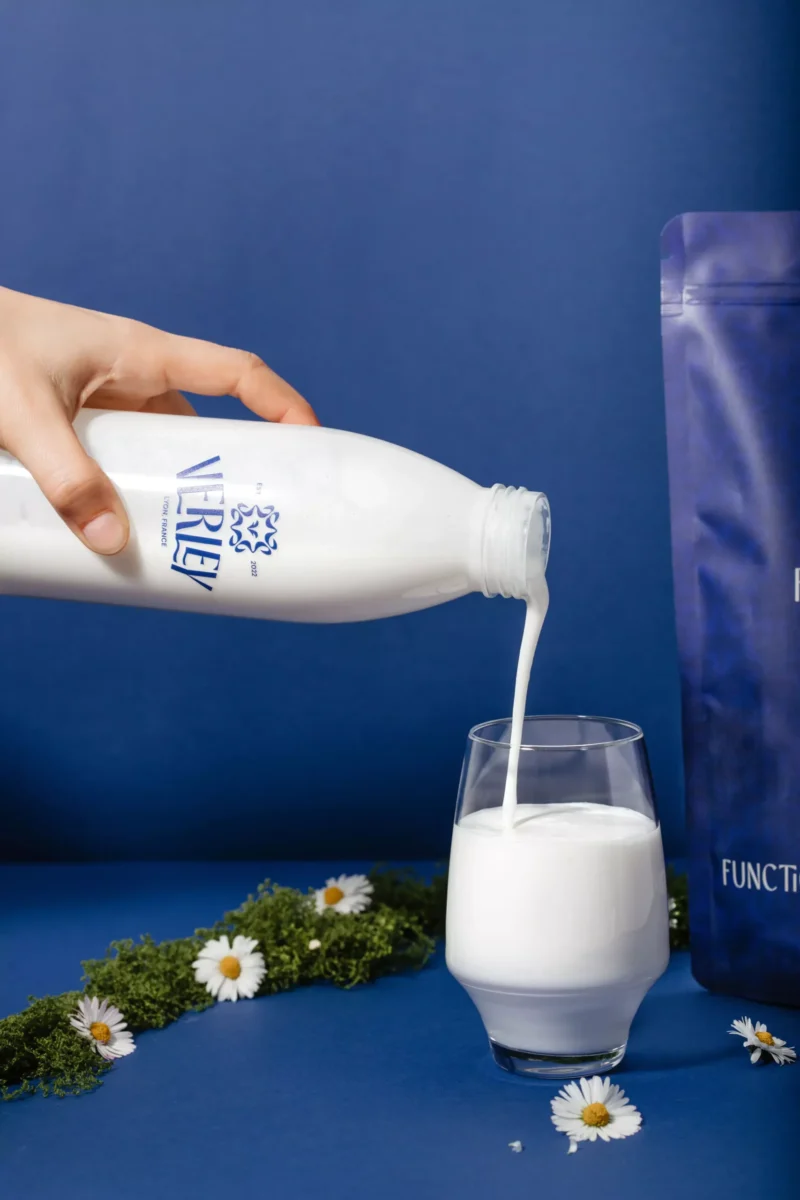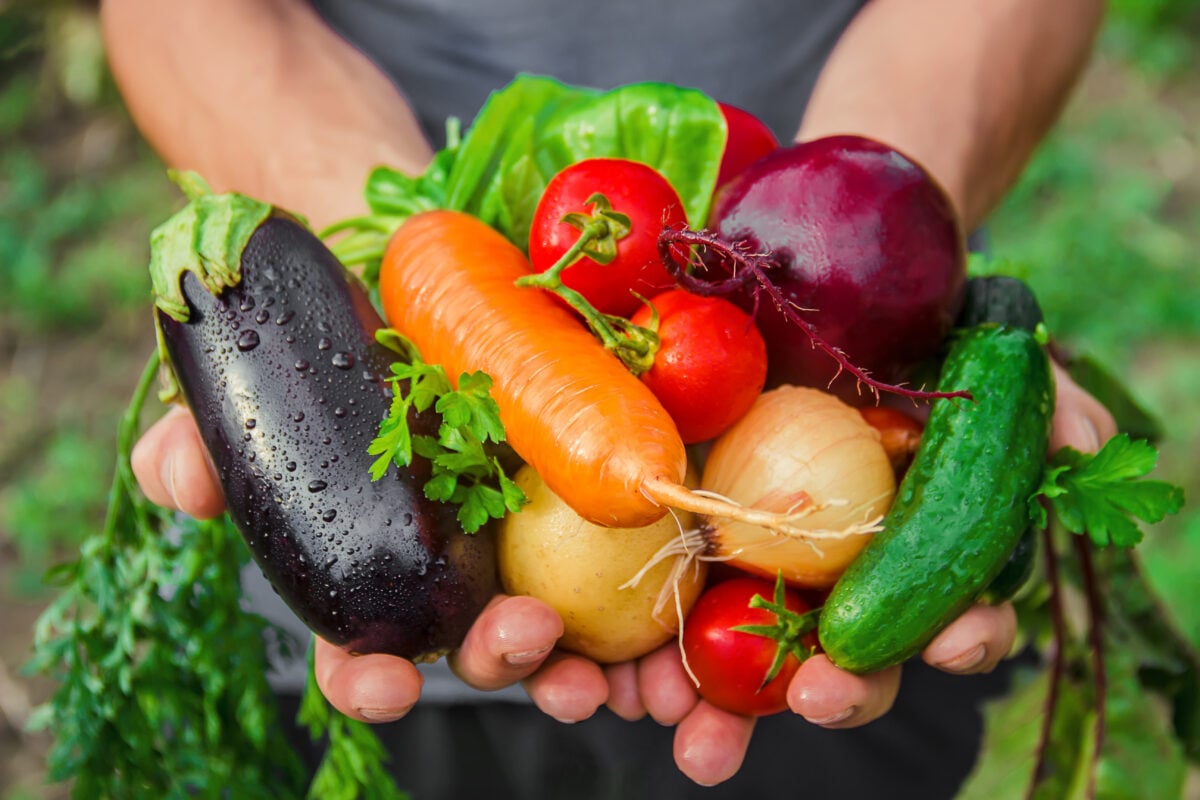Pesticides in Food, Exposure in The Standard American Diet- 80 Percent From Meat
More than 80 percent of pesticides in food exposure in the standard American diet comes from animal products, not from fruits or vegetables.
Milos Pokimica
Written By: Milos Pokimica
Medically Reviewed by: Dr. Xiùying Wáng, M.D.
Updated August 4, 2023The agricultural revolution led to the rise of the human population, and that is not something that can change no matter how much we encourage environment-friendly solutions. One thing, and maybe the only thing we are able to do is to lower our exposure to pollution by going organic and going low on a food chain as much as possible.
Most of the pesticides in food and especially heavy metals and other toxic waste pollutants we get, we get from meat.
There is a misconception that when we clean or wash pesticides from plants we lower our exposure. Most of the pesticide deposits cannot be removed by washing. They are mostly made on an oily base so that rain won’t wash them off. Correct numbers are just a couple of percent overall. Washing the apple removes around 15%, and peeling removes around 85% but also removes most of the nutrition in the peal. If you do not eat organic and most of us do not, then do wash and scrub all produce thoroughly under running water. When you soak, there is no abrasive effect that running water provides. Running water will help remove bacteria (some of them may come from animal feces and be dangerous). There are also toxic chemicals on the surface of fruits and vegetables and dirt from crevices.
However, the real truth is that more than 80 percent of pesticides in food exposure in the standard American diet come from animal products, not from fruits or vegetables.
I do not mean just fish with DDT and mercury accumulation from the ocean. Regular animal fat on farms accumulates toxins in the same manner. Cows, pigs, sheep, and chickens are held in unsanitary and overcrowded conditions that exist on factory farms. To prevent pest infestation, they are directly sprayed with pesticides. Also, they are exposed to a large number of crop pesticides through their food. Animal feed sprayed with pesticides represent the primary source of exposure from pesticides in food. Somehow we forget that all or most of the food that goes to animal feed are sprayed too. This is somehow not angulated by most people. By the estimates of the Environmental Working Group, every year in the U.S. around 167 million pounds of pesticides are just used to grow animal feed. These pesticides are eaten, and then they accumulate in animals. Pesticides are fat-soluble substances so every single gram will be assimilated into the adipose tissue of the animals and will end up on our plates eventually. This can be allowed because there is no restriction in legal terms for pesticides used in animal feed. For instance, the most commonly used pesticide in the world is glyphosate. Legally, residues that are allowed in animal feed are more than 100 times than what is allowed on grains consumed directly by humans. What is even worse is that animals eat enormous amounts of feed during the day and all of the toxins just get concentrated even more. It is a term known as biomagnification in a food chain.
The amount of glyphosate allowed in red meat that you buy in the store is more than 20 times that for most plant crops. There is a wide range of other different substances that agencies don’t even test for. These regulations have nothing to do with preserving public health, and nobody likes to talk about this because you cannot rinse pesticides out of the meat, so this information is kept out of the public.
All of that poison is not going to disappear when we grill our burger magically. Most of the pesticides in the food we will ingest or let’s say most of the people will ingest comes from animal products. Meat cannot be peeled or washed.
This is a quote from the FDA website (click here):
“Do animals eat GMO crops?
More than 95% of animals used for meat and dairy in the United States eat GMO crops. Research shows that eggs, dairy products, and meat from animals that eat GMO food are equal in nutritional value, safety, and quality to foods made from animals that eat only non-GMO food. Studies also show that the health and safety of animals are the same whether they eat GMO or non-GMO foods
When animals eat GMO foods, the DNA in the GMO food does not transfer into the DNA of the animal that eats it. This means that animals that eat GMO food do not turn into GMOs. If the DNA did transfer from food into the animal that eats it, an animal would have the DNA of any food it ate, GMO or not. In other words, cows do not become the grass they eat, and chickens don’t become the corn they eat. Similarly, the DNA from GMO food for animals is not in the meat, eggs, or milk from the animal.
Who makes sure food for animals is safe?
The U.S. Food and Drug Administration (FDA) is the primary regulatory agency responsible for ensuring the safety of GMO and non-GMO food for animals. The FDA Center for Veterinary Medicine manages this responsibility. FDA requires that all food for animals be safe for animals to eat, be produced under clean conditions, contain no harmful substances, and be accurately labeled—similar to the requirements for foods for humans.”
They deliberately don’t want you to know the real truth. All of this is true to some extent but irrelevant. The reason animals eat GMOs in the first place is because GMO corn can be sprayed with Roundup and other more potent pesticides. Nutritional value is not the same as in organic farming, commercial land is depleted of all minerals, but even if it is, you will still eat all of those fat-soluble pesticides that will accumulate in the fat of the animals. We will see in other articles just how much of the toxic overload Americans are exposed to in real life. Something FDA doesn’t like to talk about because then they will no longer be able to protect their big industries. They like to call their GMO marketing initiative “Feed Your Mind” (www.fda.gov/feedyourmind).
There is also something called cannibalistic feed biomagnification. Mercury is not just in fish. We feed a fish meal to other farm animals. Even to the cattle. Farmers discovered that if they feed animal protein to the cattle by mixing it with other plant food sources, cattle tend to grow more and produce more milk. It is not just humans that can eat animal protein all plant-eaters can eat animal protein if the protein is first heated and treated even grazers. Psychologically we think we are omnivores because we can eat thermally processed meat but that is not the case. If you do not believe me here is one study (Atwal et al., 1992). This study’s conclusion was:
“There seems to be a good reason to feed a good quality protein like a fish meal to cows producing more than 30 kg/d of milk.”
Fish-eating cows produce milk that has no aftertaste, so yes this study was a success. Except for mercury. We get saturated fat from milk and meat and all of the rest of the bad stuff, and as surplus, we also get mercury from fish in the milk of the cows too.
When we test all of the food products for toxic pollution levels, number one is fish number two is chicken. The two “healthy” types of meat. Cheese comes the third. Worst than butter or bacon.
We also feed all of the slaughterhouse waste products of animals to other animals. Because of cannibalism the pollutants just circle around.
The economically well-designed but extremely toxic trend among affluent countries is to feed any animal byproducts that cannot be eaten by humans to poultry and ruminants (herbivores such as sheep, cows, and goats). In industry, nothing is wasted including bones, manure, blood, heads, and so on. Most of it goes to dog food or animal food. All of the blood, bones and even roadkill corpses, supermarket waste meat, anything from the city shelter, work animals, euthanized pets, and any protein no matter how decaying are grounded together, then heated to sterilize them, then dried, and then used as animal feed. It is all part of the rendering business.

Inedible dead animals and that means all of them including dogs and cats and other dead pets like reptiles, insects, or anything that is no longer alive, end up in feed used to fatten up future generations of their own kind. Protein is a protein. What cannot be used as animal feed or in other words that can be extracted for more expensive products will end up transmogrified into rubber, car wax, paint, and industrial lubricants. Some of it even goes to animal feed for chicken or fish farms and will not be used for pallets for pets meaning it will end up eventually on our own kitchen table. Most of the toxins that are thermostable will persist from one species to another. Prion disease is one good example of what can come out of this (Mad cow disease). Not only are harmful prions found in the meats of animals, all other pollutants just get passed from one animal to another and eventually will end up on our own plate.
People have a hard time with this data so let us look at some studies.
For example, if we look at perfluorooctane sulfonates almost all of it comes from meat and fish (Kannan et al., 2004).
In this study, they measured the levels of the dietary influx of PCBs and organochlorine pesticides for children and adults (Fromberg et al., 2011). For PCP it was the number one fish than meat, fats, cheese, dairy, eggs poultry. For DDT it was fish, meat, fat, dairy, cheese, and eggs. For HCB (hexachlorobenzene) it was the same. These substances are fat-soluble and are in the environment and they bioaccumulate in the food chain.
What about Dioxins?
Every five years, the US government releases a report about the number of dioxins in the food supply because they have to by law. This type of toxin is fat-soluble and it will also bioaccumulate in the food chain. Dioxins are toxic waste pollutants spewed out into the atmosphere by combustion in different types of industries and will eventually end up in the ocean for eternity to come. So the fish is number one and number two would be eggs, and then the rest of the meats. The problem is that in America the entire population is well above the upper tolerable exposure limit for both PCP and Dioxins set by the cancer prevention board in every age group (Lorber et al., 2009). The situation can become much worse if you want to become pregnant.
And these would be just a couple of substances I use as an example. The number of pesticides in food and environmental toxins we are exposed to is outstanding. There is a “dirty dozen” list but the real number is in the hundreds. Maybe even thousands. There is no real science in all of these chemicals yet. There are too many of them and nobody wants to do research because that will make a business more expensive.
One more false narrative is that somehow grass-fed beef is healthier and less polluted and in a logical sense it should be. The only problem is that when tested for carcinogenicity because our world by now is so polluted even that organically grown meat was shown to be only marginally less carcinogenic. Today only real organic meat would be wild game meat but this has to be a subject for another article.
References:
- Gilbert, J. (2005). Environmental contaminants and pesticides in animal feed and meat. Improving the Safety of Fresh Meat, 132-155. https://doi.org/10.1533/9781845691028.1.132
- LeDoux M. (2011). Analytical methods applied to the determination of pesticide residues in foods of animal origin. A review of the past two decades. Journal of chromatography. A, 1218(8), 1021–1036. https://doi.org/10.1016/j.chroma.2010.12.097
- Atwal, A. S., & Erfle, J. D. (1992). Effects of feeding fish meal to cows on digestibility, milk production, and milk composition. Journal of dairy science, 75(2), 502–507. https://doi.org/10.3168/jds.S0022-0302(92)77787-X
- Kannan, K., Corsolini, S., Falandysz, J., Fillmann, G., Kumar, K. S., Loganathan, B. G., Mohd, M. A., Olivero, J., Van Wouwe, N., Yang, J. H., & Aldoust, K. M. (2004). Perfluorooctanesulfonate and related fluorochemicals in human blood from several countries. Environmental science & technology, 38(17), 4489–4495. https://doi.org/10.1021/es0493446
- Fromberg, A., Granby, K., Højgård, A., Fagt, S., & Larsen, J. (2011). Estimation of dietary intake of PCB and organochlorine pesticides for children and adults. Food Chemistry, 125(4), 1179-1187. https://doi.org/10.1016/j.foodchem.2010.10.025
- Lorber, M., Patterson, D., Huwe, J., & Kahn, H. (2009). Evaluation of background exposures of Americans to dioxin-like compounds in the 1990s and the 2000s. Chemosphere, 77(5), 640–651. https://doi.org/10.1016/j.chemosphere.2009.08.016
Related Posts
Do you have any questions about nutrition and health?
I would love to hear from you and answer them in my next post. I appreciate your input and opinion and I look forward to hearing from you soon. I also invite you to follow us on Facebook, Instagram, and Pinterest for more diet, nutrition, and health content. You can leave a comment there and connect with other health enthusiasts, share your tips and experiences, and get support and encouragement from our team and community.
I hope that this post was informative and enjoyable for you and that you are prepared to apply the insights you learned. If you found this post helpful, please share it with your friends and family who might also benefit from it. You never know who might need some guidance and support on their health journey.
– You Might Also Like –

Learn About Nutrition
Milos Pokimica is a doctor of natural medicine, clinical nutritionist, medical health and nutrition writer, and nutritional science advisor. Author of the book series Go Vegan? Review of Science, he also operates the natural health website GoVeganWay.com
Medical Disclaimer
GoVeganWay.com brings you reviews of the latest nutrition and health-related research. The information provided represents the personal opinion of the author and is not intended nor implied to be a substitute for professional medical advice, diagnosis, or treatment. The information provided is for informational purposes only and is not intended to serve as a substitute for the consultation, diagnosis, and/or medical treatment of a qualified physician or healthcare provider.NEVER DISREGARD PROFESSIONAL MEDICAL ADVICE OR DELAY SEEKING MEDICAL TREATMENT BECAUSE OF SOMETHING YOU HAVE READ ON OR ACCESSED THROUGH GoVeganWay.com
NEVER APPLY ANY LIFESTYLE CHANGES OR ANY CHANGES AT ALL AS A CONSEQUENCE OF SOMETHING YOU HAVE READ IN GoVeganWay.com BEFORE CONSULTING LICENCED MEDICAL PRACTITIONER.
In the event of a medical emergency, call a doctor or 911 immediately. GoVeganWay.com does not recommend or endorse any specific groups, organizations, tests, physicians, products, procedures, opinions, or other information that may be mentioned inside.
Editor Picks –
Milos Pokimica is a doctor of natural medicine, clinical nutritionist, medical health and nutrition writer, and nutritional science advisor. Author of the book series Go Vegan? Review of Science, he also operates the natural health website GoVeganWay.com
Latest Articles –
Plant Based News
-
Some Dogs Can Sort Toys By Function, Says New Study On Canine ‘Label Extension’
on November 5, 2025
-
Courgette, Leek, White Bean And Kale Stew
on November 5, 2025
-
Precision Fermented Dairy Proteins Receive ‘No Questions’ Approval From FDA
on November 4, 2025
-
This One-Pan Ramen Is Ready In 30 Minutes
on November 4, 2025
-
How to Make Fresh Vanilla Hemp Milk at Home
on November 3, 2025
-
Animal Farming Is ‘World’s Biggest Cause Of Food Waste,’ Says Report
on November 3, 2025
-
Butter Bean And Sweet Papas Coconut Stew
on November 2, 2025
Top Health News — ScienceDaily
- Scientists uncover meditation’s hidden side effectson November 5, 2025
Meditation is widely praised for its mental health benefits, but new research shows that it can also produce unexpected side effects for some people—from anxiety and dissociation to functional impairment. Psychologist Nicholas Van Dam and his team found that nearly 60% of meditators experienced some kind of effect, and about a third found them distressing.
- Most Americans don’t know alcohol can cause canceron November 5, 2025
Most U.S. adults don’t realize alcohol raises cancer risk, and drinkers themselves are the least aware. Scientists say targeting these misbeliefs could significantly reduce alcohol-related cancer deaths.
- A breakthrough map reveals how the brain really workson November 5, 2025
Scientists have shown that brain connectivity patterns can predict mental functions across the entire brain. Each region has a unique “connectivity fingerprint” tied to its role in cognition, from language to memory. The strongest links were found in higher-level thinking skills that take years to develop. This work lays the groundwork for comparing healthy and disordered brains.
- A shapeshifting protein explains rabies’ deadly poweron November 5, 2025
Researchers discovered how rabies virus exerts massive control over host cells with very few genes. A key viral protein changes shape and binds RNA, allowing it to infiltrate different cellular systems. This adaptability could explain the power of other deadly viruses, including Nipah and Ebola. The breakthrough may lead to next-generation antivirals or vaccines.
- Cockroaches are secretly poisoning indoor airon November 5, 2025
Cockroach infestations don’t just bring creepy crawlers, they fill homes with allergens and bacterial toxins that can trigger asthma and allergies. NC State researchers found that larger infestations meant higher toxin levels, especially from female roaches. When extermination eliminated the pests, both allergens and endotoxins plummeted. The findings highlight how pest control is vital for cleaner, healthier air indoors.
- Scientists shocked to find E. coli spreads as fast as the swine fluon November 5, 2025
Researchers have, for the first time, estimated how quickly E. coli bacteria can spread between people — and one strain moves as fast as swine flu. Using genomic data from the UK and Norway, scientists modeled bacterial transmission rates and discovered key differences between strains. Their work offers a new way to monitor and control antibiotic-resistant bacteria in both communities and hospitals.
- Tiny molecules could stop glaucoma before it blindson November 5, 2025
Scientists at Mizzou have identified two small molecules, agmatine and thiamine, that could both reveal and fight glaucoma. Their research shows these compounds are lower in glaucoma patients, suggesting they may serve as early warning markers. Even better, they might help protect retinal cells from damage, potentially slowing or stopping vision loss. The discovery could revolutionize how the disease is detected and treated.
PubMed, #vegan-diet –
- Impact of in vitro digestion on the cytotoxicity and microbial viability of cholinesterase-inhibitor-rich vegan soups in human intestinal cell modelson November 1, 2025
Vegan lunch soups formulated with mushroom, asparagus, leek, and sea buckthorn were previously developed by our team to provide a consistent daily intake of dietary cholinesterase inhibitors. Considering the proposed continuous consumption of these functional soups, it is essential to examine any cytotoxic responses that may occur in the gastro-intestinal tract. This work starts this topic by investigating the effect of in vitro digested soups towards selected human intestinal cells and…
- A 6-Month, Prospective, Multi-arm Study for the Efficacy of Standardized Nutraceuticals to Improve Hair Fiber Thickness and Strengthon October 31, 2025
CONCLUSIONS: This study demonstrates that ingestion of these bio-specific HGNs are associated with significantly enhanced hair shaft diameter and decreased breakage, resulting in longer, stronger hair across their intended populations. These findings support the use of these HGNs for hair thinning, offering alternative options for various populations for improving hair growth and thickness.
- Consumer Acceptance of Sustainable Cat Diets: A Survey of 1380 Cat Guardianson October 29, 2025
There is increasing awareness about the adverse environmental and ‘food’ animal welfare impacts associated with the production of meat-based pet food. However, little is known about cat guardians’ acceptance of more sustainable food choices for the global population of approximately 476 million pet cats. By surveying 1380 cat guardians, this study explored feeding patterns used by guardians, determinants of their cat food choices, and their acceptance levels of more sustainable cat food…
- Consumer Acceptance of Sustainable Dog Diets: A Survey of 2639 Dog Guardianson October 29, 2025
Interest in more sustainable diets for the global population of 528 million companion dogs is steadily increasing, encompassing nutritionally sound cultivated meat, vegan, and microbial protein-based dog foods. Factors driving these alternative dog foods include lower impacts on the environment, fewer welfare problems related to intensively farmed animals and wild-caught fish, and potentially superior canine health outcomes, relative to conventional meat-based dog food. Through a […]
- Beliefs and behaviours associated with vegetarian, vegan, and gluten-free diets among Canadians capable of bearing childrenon October 29, 2025
There is increased interest in self-selected exclusionary diet patterns, specifically vegetarian, vegan, and gluten-free (GF) diets, but there is a lack of research exploring the beliefs and behaviours surrounding these diets in Canadians capable of bearing children (CCBC). The goal of this study was to explore the beliefs and behaviours of CCBC who follow vegetarian, vegan, and/or GF diets using mixed methods. A self-administered online Qualtrics™ survey containing 102 questions was […]
Random Posts –
Featured Posts –

Latest from PubMed, #plant-based diet –
- Diet quality scores and incidence of cardiovascular events: A 4-year prospective study of patients in cardiology secondary care (BALANCE Program Trial)by Aline Rosignoli da Conceição on November 5, 2025
As a modifiable determinant, dietary patterns are a crucial factor in the prevention of cardiovascular disease (CVD), as they account for more than half of all CVD-related deaths and disabilities. Thus, we aimed to assess whether changes in diet quality along with six a priori-defined diet scores were associated with the incidence of cardiovascular (CV) events during four years of follow-up of secondary care cardiology patients. We conducted a secondary prospective analysis of 1,704, 1,629 […]
- Dietary animal fat disrupts gut microbiota and aggravates Scl-cGVHD after allogeneic hematopoietic stem cell transferby Danielle D Millick on November 5, 2025
Allogeneic Hematopoietic Stem Cell Transplant (allo-HCT) is an effective treatment for high-risk or relapsed acute leukemia. However, the frequent occurrence of graft-versus-host disease (GVHD) poses significant complications. Modifiable factors such as the gut microbiome and dietary regimen have the potential to influence the frequency and severity of GVHD. Previous studies in mouse models have shown a direct link between obesity and increased severity of GVHD. Analysis of human data has not…
- Dose-response effects of a mixed condensed and hydrolyzable tannin extract on methane production and diet digestibility using the in vitro gas production techniqueby Jordan M Adams on November 5, 2025
Several studies have evaluated the impact of isolated condensed or hydrolyzable tannin extract (TE) supplementation for beef cattle on methane (CH4) mitigation and metabolic functions, but fewer have evaluated their combination. Our objective was to investigate changes in in vitro fermentation dynamics, CH4 production, neutral detergent fiber digestibility (ivNDFD), and ruminal volatile fatty acid (VFA) concentrations in response to the inclusion rate of a TE blend (Silvafeed ByPro; […]
- Discovery of urinary biomarkers of kiwifruit intake in a randomized intervention studyby Zilin Xiao on November 4, 2025
CONCLUSIONS: This study identified potential biomarkers of kiwifruit and developed a prediction model that may differentiate consumers. Further validation is necessary to confirm the reliability and generalizability of our findings.
- Nourishing the Skin: A Review of Diet’s Role in Hidradenitis Suppurativaby Jordan Beam on November 4, 2025
Hidradenitis suppurativa (HS) is a complex skin condition influenced by both genetic and environmental factors. Increasing evidence points to diet as a key contributor to disease severity through systemic inflammatory pathways. A review of recent literature was conducted to evaluate the relationship between dietary patterns and advancement of HS. Pro-inflammatory diets such as the Western diet, leucine-rich diets, and brewer’s yeast were associated with HS exacerbation through mTOR activation…
- Energy balance in cyclists on plant-based diets during a 30-day, 4300-km ride across Canada: Two case studiesby Sarah A Purcell on November 3, 2025
The popularity of ultra-endurance events and plant-based diets highlights the importance of understanding the energetics of athletes with diverse dietary preferences. This study examined energy balance in two recreational cyclists on plant-based diets (male, 41 years; female, 38 years) during a 30-day cross-Canada ride. Resting energy expenditure was measured via whole-room indirect calorimetry before and after the ride. Total energy expenditure (TEE) was assessed using doubly labeled water…










































